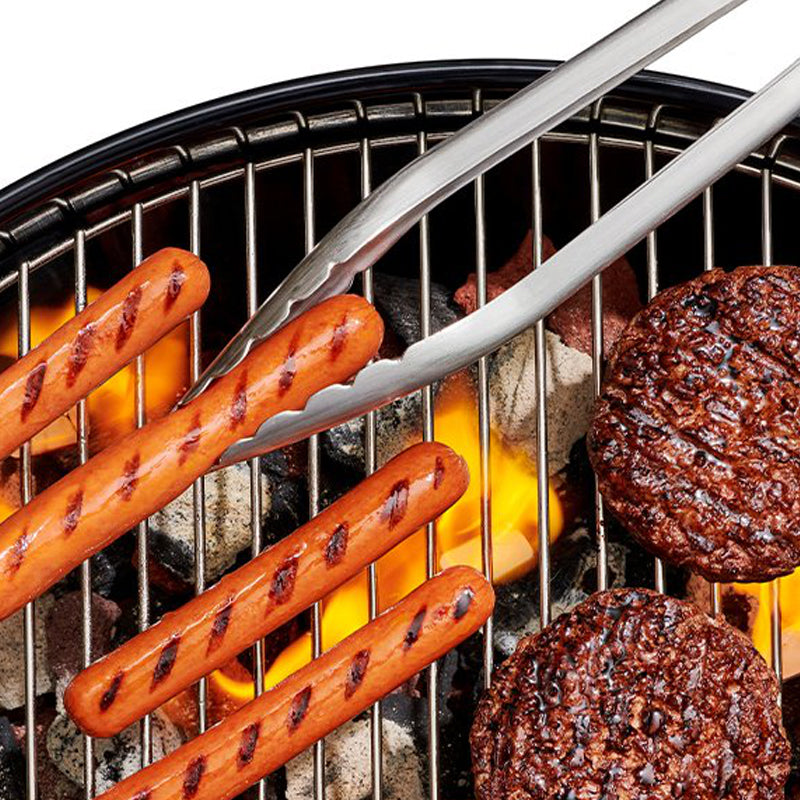That thing outside on your patio or deck—is it a barbecue or is it a grill? And when you cook on it, are you “barbecuing” or “grilling”? All good questions…and we’ve got answers.
You’ll often hear the terms “barbecuing” and “grilling” used interchangeably, but there’s actually a big difference between the two. Barbecuing cooks food slowly and often incorporates sauces or marinades. It infuses a smoky taste and makes food extra tender. Meanwhile, grilling cooks ingredients quickly and is normally done with very little oil, resulting in that crispy, charred, caramelized surface and those picture-perfect grill marks. So, when it comes to grilling vs. barbecuing, how do you know which method to choose and when?

Barbecuing
If you’re dreaming of succulent ribs or full-flavored shredded pork sandwiches, barbecuing is the way to go. Primarily used for meats, barbecuing cooks at low heat (usually around 225°F) for a longer time (anywhere from a few hours to overnight). It’s also a great method for cooking thicker cuts of pork or beef that could use some extra pounding with a meat tenderizer. You can even barbecue a whole turkey or chicken.
To barbecue meats in the authentic low-and-slow way, you’ll need equipment that separates the heat source from the food, such as a ceramic tray and drip pan that you place between the smoldering charcoal briquettes and the grill rack. You’ll also need a closed lid to control and recirculate the heat. And to get the best results, you’ll want to flavor your meats with dry rubs or marinades, which you can apply during the cooking process with a flavor injector or a basting brush.

Grilling
Thinking of having a few friends over for a July 4th backyard party or a summer weekend get-together, and quickly whipping up a few favorites like steaks and burgers, grilled vegetables or hotdogs? Then chances are you’re planning on using the grill versus the barbecue option. Grilling also happens to be incredibly versatile, since you can use it to make unexpectedly delicious options like grilled pizza, grilled fruits like watermelon or pineapple, or even grilled citrus—all of which can be enjoyed as stand-alone side dishes or incorporated into a summertime salad.
No matter whether you’re using a gas, charcoal, kamado or another kind of grill, the key to perfectly grilled foods is a high temperature (usually around 450° to 500°F) and the ability to expose the food directly to a heat source so that the surface becomes charred and caramelized. Using a grill rack gives your food those beautiful grill marks and allows the flames to come in contact with the ingredients, but grilling can also be done on a griddle pan (a flat surface similar to a large frying pan). The high temperatures you use for grilling will sear the surface of the food quickly, but keep in mind that before serving, you’ll need to ensure that the internal temperature of any meat you grill reaches at least 125°F for medium rare beef, 165°F for chicken, and 145°F for pork.

Planning Ahead
Although grilling and barbecuing are different kinds of cooking methods, they actually require similar gear and preparation. Doing a deep dive on grilling safety and techniques is a great way to up your game and become a confident grill master, but here’s a quick checklist of what you need to do to get started:
Make sure you have enough fuel
Stock up on charcoal or refill your propane tank so that you’ve got what you need on hand.
Clean and season your equipment’s surfaces
Before you ignite your grill or barbecue, scrape off the grill grate with a wire brush. If you’re using the griddle surface, wipe it down with a damp cloth. Then lubricate the grate or griddle with a small amount of oil with a high smoke point, such as avocado or canola oil, to prevent food from sticking.
Prep your ingredients
Getting your mise en place together—which means organizing your cooking and ingredients ahead of time—will make everything go more smoothly. Wash and chop any vegetables you’ll need. Marinate your meat, chicken or seafood in a covered dish for up to several hours before cooking. Prepare any sauces and put them into squeeze bottles. Gather any breads, condiments and garnishes you’ll want to set out.
Set up your utensils
Before you start cooking, make sure you have all the necessary utensils on hand, including:
- A grilling turner for flipping burgers
- A precision turner for handling more delicate items like fish
- Metal skewers for pieces of meat, seafood or even fruit
- A set of grilling tongs
- A meat thermometer
- A grilling brush for basting your barbecue as you go
- And of course, a place to rest your grilling tools
Now that we’re all clear on the differences between barbecue and grilling, how about some fun summer cocktails to go with your outdoor food fest?

